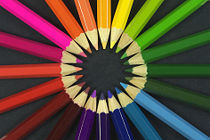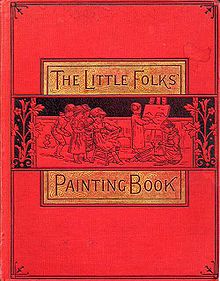- Coloring book
-
A coloring book (or colouring book, see spelling differences) is a type of book containing line art for a reader to add color using crayons, colored pencils, marker pens, paint or other artistic media. Coloring books are generally used by children, though coloring books for adults are also available.
Contents
History
Paint books and coloring books emerged in the United States as part of the "democratization of art" process, inspired by a series of lectures by British artist Joshua Reynolds, and the works of Swiss educator Johann Heinrich Pestalozzi and his student Friedrich Fröbel. Many educators concluded that all, regardless of background, students stood to benefit from art education as a means of enhancing their conceptual understanding of the tangible, developing their cognitive abilities, and improving skills that would be useful in finding a profession, as well as for the children's spiritual edification.[1] The McLoughlin Brothers are credited as the inventors of the coloring book, when, in the 1880s, they produced The Little Folks' Painting Book, in collaboration with Kate Greenaway. They continued to publish coloring books until the 1920s, when the McLoughlin Brothers became part of the Milton Bradley Company.
Another pioneer in the genre was Richard F. Outcault. He authored Buster's Paint Book in 1907, featuring the character of Buster Brown, which he had invented in 1902. It was published by the Stokes Company. This launched a trend to use coloring books to advertise a wide variety of products, including coffee and pianos.[1] Until the 1930s, books were designed with the intent for them to be painted instead of colored. Even when crayons came into wide use in the '30s, books were still designed so that they could be painted or colored.[2]
Educational uses
As a predominately non-verbal medium, coloring books have seen wide application in education where the target groups do not speak and understand the primary language of instruction or communication. Examples of this include the use of coloring books in Guatemala to teach children about "hieroglyphs and Mayan artist patterns",[3] and the production of coloring books to educate the children of farm workers about "the pathway by which agricultural pesticides are transferred from work to home."[4] Coloring books are also said to help to motivate students' understanding of concepts that they would otherwise be uninterested in. Since the 1980s, several publishers have also produced educational coloring books intended for studying graduate-level topics such as anatomy and physiology, where color-coding of many detailed diagrams are used as a learning aid.
There is also a reputedly excellent textbook on the Fortran programming language, called A Fortran Coloring Book,[5] that is presented as a tongue-in-cheek coloring book.
Health and therapeutic uses
Coloring books have seen wide application in the health professions as educational tools. One nurse, trying to limit the trauma of child surgery, described in an academic publication how the use of a coloring book "might help [the child] to understand what was going to happen to him."[6] They are used in rehabilitation of accident victims to aid recovery of hand-eye coordination, and they are used with autistic children both for entertainment and for their soothing affect. It should be noted however that some autistic children will react strongly to bright colors, and that the use of paint and paint-brushes can lead to accidents that may greatly upset the child. For this reason a software based coloring book may be a better option.
Political uses
Coloring books have sometimes been used for political ends. In 1968 the Black Panther Coloring Book began circulating in the United States. The book, which featured black men and children killing pigs dressed as police officers, was not actually made by the Black Panther Party, instead being made by the Federal Bureau of Investigation's COINTELPRO program to discredit the organization.[7][8]
The term and concept of the "coloring book" was adopted by the feminist artist Tee Corinne as a tool of female empowerment. Corinne made pencil sketches of female genitalia, which she then inked and printed on card stock. She published a collection of them in 1975 as The Cunt Coloring Book.
“ No other name seemed really to fit, although the word "cunt" was not one with which I was particularly comfortable. The alliteration, though, was nice. I also liked the idea of combining a street term for genitalia with a coloring book, because both are ways that, as children, we get to know the world.[9] ” Printed coloring books
 Coloring pencils are commonly used to fill in coloring books.
Coloring pencils are commonly used to fill in coloring books.
Traditional Coloring Books and Coloring Pages are printed on paper or card. Some coloring books have perforated edges so their pages can be removed from the books and used as individual sheets. Others may include a story line and so are intended to be left intact. Today many children's coloring books feature popular cartoon characters. They are often used as promotional materials for animated motion pictures. Coloring books may also incorporate other activities such as Connect the dots, mazes and other puzzles. Some Coloring Books also incorporate the use of stickers.
Notes
- ^ a b "Drawn to Art: Art Education and the American Experience, 1800-1950" exhibition review.
- ^ Pat Jacobs. "Coloring Books". http://www.loti.com/then_now/Coloring_Books.htm. Retrieved 2007-04-15.
- ^ Misheff, Sue (September 1994). "Perspectives of Children's Literature in Guatemala". Hispania 77 (3): 524–531. doi:10.2307/344988. JSTOR 344988.
- ^ Drew, Christina H.; Deirdre A. Grace; Susan M. Silbernagel; Erin S. Hemmings; Alan Smith; William C. Griffith; Timothy K. Takaro; Elaine M. Faustman (March 2003). "Nuclear Waste Transportation: Case Studies of Identifying Stakeholder Risk Information Needs". Environmental Health Perspectives 111 (3): 263–272. doi:10.1289/ehp.5203. PMC 1241381. PMID 12611653. http://www.pubmedcentral.nih.gov/articlerender.fcgi?tool=pmcentrez&artid=1241381.
- ^ Kaufman, Roger (1978). A FORTRAN Coloring Book. Cambridge, Massachusetts and London England: MIT Press. pp. 285. ISBN 0 262 61026 4.
- ^ Harris, Carolyn (January 1961). "Tonsil Season". The American Journal of Nursing 61 (1): 91–92. doi:10.2307/3451768. JSTOR 3451768.
- ^ Some commentators have alleged that the book was a piece of FBI agitprop. See Jorgenson, Carl (Spring-Summer 1984). "Blacks in the 60s: A Centennial Reprise". Social Text (9/10): 313–317. doi:10.2307/466577. JSTOR 466577.. Others accept the text as genuine.Lane, R.D. (Spring 1998). "'Keepin' it Real': Walter Dean Myers and the Promise of African-American Children's Literature". African American Review 32 (1): 125–138. doi:10.2307/3042275. JSTOR 3042275.
- ^ "Police And Panthers: Growing Paranoia". Time Magazine. December 19, 1969. http://www.time.com/time/magazine/article/0,9171,941720-1,00.html. Retrieved 2007-04-14.
- ^ Corinne, Tee (Summer 1993). "Artist's Statement: On Sexual Art". Feminist Studies 19 (2): 369–376. doi:10.2307/3178374. JSTOR 3178374.
Categories:- Books by type
- Painting
Wikimedia Foundation. 2010.

